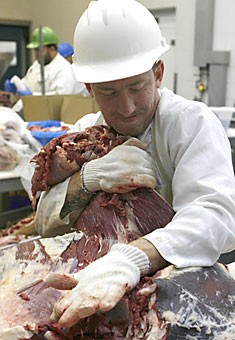Physics labs, check.
Recreation center, check.
Slaughterhouse, check?
The UA owns a meat sciences facility housing a self-sufficient slaughterhouse and meat-processing lab that teaches students about safety, animal composition and meat processing.
“”We encompass all animal sciences as well as veterinary and microbiology students,”” said John Marchello, an instructor and employee at the facility, located at the UA Agricultural Research Center, 4101 N. Campbell Avenue.
The facility employs less than 10 full-time employees and is used by many departments at the UA, Marchello said.
“”There are 60-some different parts of the university, high schools and middle schools that get parts and things like that for their science classes,”” he added.
Students studying animal sciences take part in all of the facility’s functions, from processing animal carcasses to grading the meat to testing the meat for safety and quality, Marchello said.
To slaughter the animals, “”we use two humane procedures. Captive-bolt … knocks them out, they have to be unconscious,”” he said. “”Death is by bleeding – removing the blood.””
The captive-bolt gun, which is used on cattle and larger animals, has a bolt that uses a .22-caliber shell without the lead, Marchello said.
“”It fires that, hits them in the head and knocks them unconscious at 600 mph,”” he said. “”They don’t know what hit them.””
After the animal is unconscious, the carotid arteries are cut and the animal dies from blood loss “”within a minute or less,”” Marchello said.
The electrode method, used on hogs and smaller animals, sends an electrical current through the animal’s body, knocking it unconscious, he said. Then it is bled.
Food Safety and Inspection Services periodically sends an inspector to check out the conditions of the facility and would report to the Humane Society of Southern Arizona if conditions were less than what is considered humane, he said.
“”There are people who eat meat, and the humane slaughter of animals needs to be taught for that reason,”” said Susan Wilson, CEO of the Humane Society of Southern Arizona. “”The UA facility never received any complaints.””
The captive-bolt method is considered humane by several national organizations, Wilson said.
“”It’s the larger factory slaughterhouses that need our scrutiny,”” Wilson said. The animal sciences department has “”many people associated with it that believe in the humane treatment of animals,”” she said.
The meat sciences facility offers processed and packaged meat to consumers and restaurants in the area, Marchello said.
“”Anybody can buy it,”” he said, “”We’re very comparable to Costco and places like that.””
No restaurants in the UA student unions or on University Boulevard buy their meat from the facility because of the large quantities they need, Marchello said.
The profit from the meat sales goes toward covering the facility’s operational costs.
“”We’re pretty much self-sufficient,”” Marchello said. “”We receive a little bit of help, but not much.””
The facility is used to research animal sciences and food-safety techniques. Japanese Waygu cows, used for Kobe beef, were recently cross-bred with a South African breed called Tuli, whose meat is known for its tolerance of high temperatures, to produce an experimental beef called “”Waguli,”” Marchello said.
The grade and quality of the beef was tested at the Meat Sciences Laboratory and a report showed that the new beef is of higher quality than most of the beef available in the Southwest, Marchello said.
In addition to slaughtering and processing cattle, the facility also processes meats, including buffalo, elk and deer, for ranchers around Southern Arizona, Marchello said.
The facility also does safety tests on foods for other companies.
“”They send us samples, we do a generic E. Coli test weekly and then we get the results and fax them back to them so their inspector can see, because they don’t have the facility to do this type of testing,”” Marchello said. “”We do that for a number of people.””
The facility offers certification programs for non-UA students for meat-processing and food-safety training.
Ryan Lainson, 27, will be graduating from the meat-processing certification program at the end of the week.
The four-month course taught him the “”carcass from top to bottom,”” Lainson said, as well as “”all the muscle groups and how to break down each bone.””
“”Everything that I’ve learned here has been rewarding, and I know it’s going to help me move up when I get in my career,”” Lainson said.
Soon an option for a specialization in food safety will be available, Hamdi Ahmad, a senior research specialist at the facility.
“”Food safety is the most important issue in the food industry right now,”” he said.









